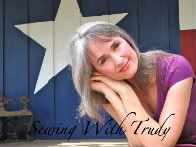Design and Drafting my daughter’s Dream Prom Dress
-
The next instalment of sewing my daughter’s dream prom dress is up on
Youtube! Today I’m sharing all about the design and pattern development
process for...
Monday, June 22, 2009
Questions & Answers
What is the best way to cut knit fabrics?
Use a rotary mat and rotary cutter to cut your knit fabric pieces.
But watch your fingers! It will be easier to maneuver around the curves if you use a small cutter with a fresh blade. Use Pattern weights to keep everything in place while cutting.
What is an easy way to do interfacing?
Interfacing can be very time consuming when cutting out each piece to be interfaced individually, then ironing the interfacing on indivdually. I have found an easier way to interface. It's similar to laminating. Use fusible tricot to interface most items. Press the interfacing onto the back of a piece of the fashion fabric large enough to cut out all facings or interfaced items. When they are cut, they will be exactly matched in size since they were cut as one. This saves a lot of time.
How do I prevent jamming at the beginning of my seam?
When you first start to sew your seam, hold on to your thread tails, your needle and bobbin threads, for the first few stitches, then you may release. This will prevent the fabric from being pulled into the throat plate and jamming. You can also start sewing on a little square of fabric that you place just ahead of your actually project you are sewing on.
It's not always easy to tell which is the right side of the fabric. What is the best way to mark the right side?
Put a safety pin in the seam allowance on the right side of the fabric on each piece to be able quickly identify which is the right side.
I am a beginner sewer, and I always seem to have trouble fitting the collar to the shirt or top. What is an easy way to do collars?
The thing to do when you are doing collars is to really take your time, go nice and slow. Baste if you feel it's necessary. Before sewing, measure everything and then make sure both sides match.
When I do collars, I prefer to do a wrapped corner. Wrapped corners give corner seams a nice "point" instead of a "bunched" corner. A normal corner is sewn by stitching down one side -- pivoting -- and sewing down the second side. Trimming seam and turning right side out.
Wrapped Corner is a multi-step procedure:
1. With right sides together, stitch the seam of one side. Trim seam. Press seam toward back or facing.
2. Understitch seam if possible (stitching seam allowance to facing)
3. With right sides together, line up second seam. The first seam line will now be on a folded edge.
4. Stitch second seam. Trim seam allowance.
5. At intersection of the two seam allowances, fold second seam so it leaves a square corner.
6. Turn project right side out, keeping the intersection at the corner folded.
7. With point turner carefully push corner out -- keeping corner smooth.
Note: You should have a smooth even corner without any "bunching" in the corner.
Note: If corner does not appear smooth, turn back inside out and re-fold corner and turn again.
This is a great technique to use when making vests to get perfect points.
Subscribe to:
Post Comments (Atom)

















































.JPG)




I like that start sewing on a little scrap to prevent thread jamming at the start of a seam. This happens to me all the time! I really like your blog.
ReplyDelete